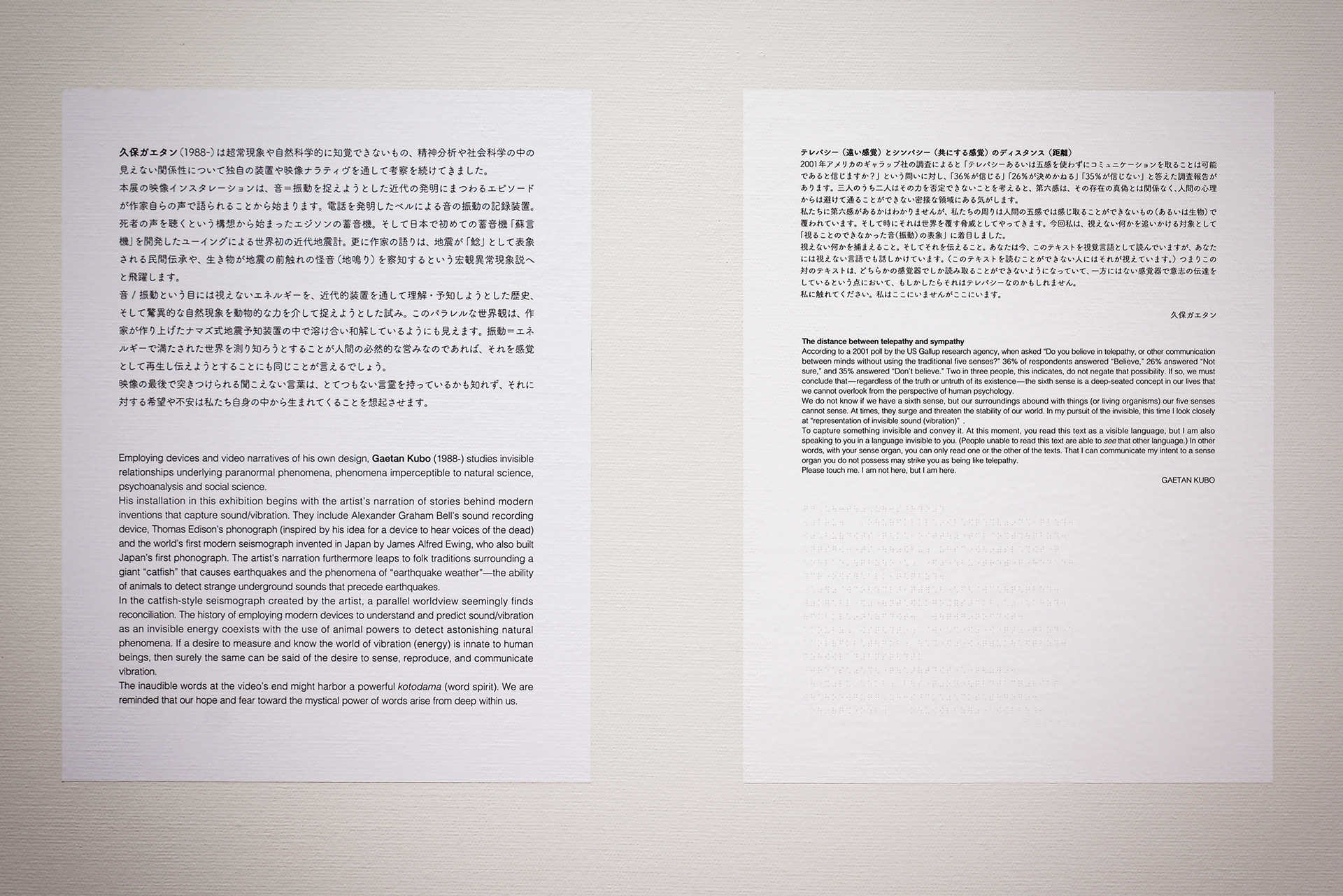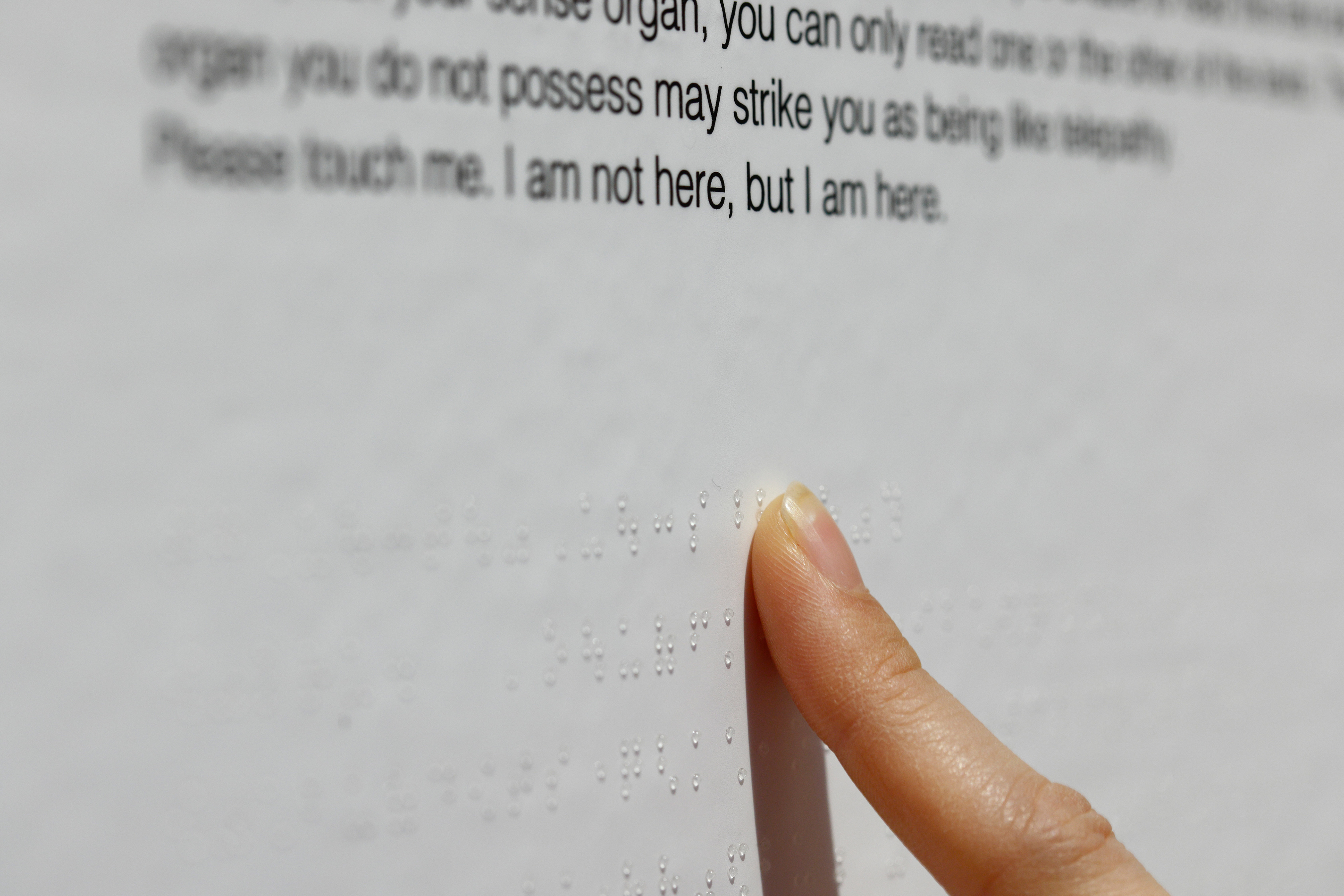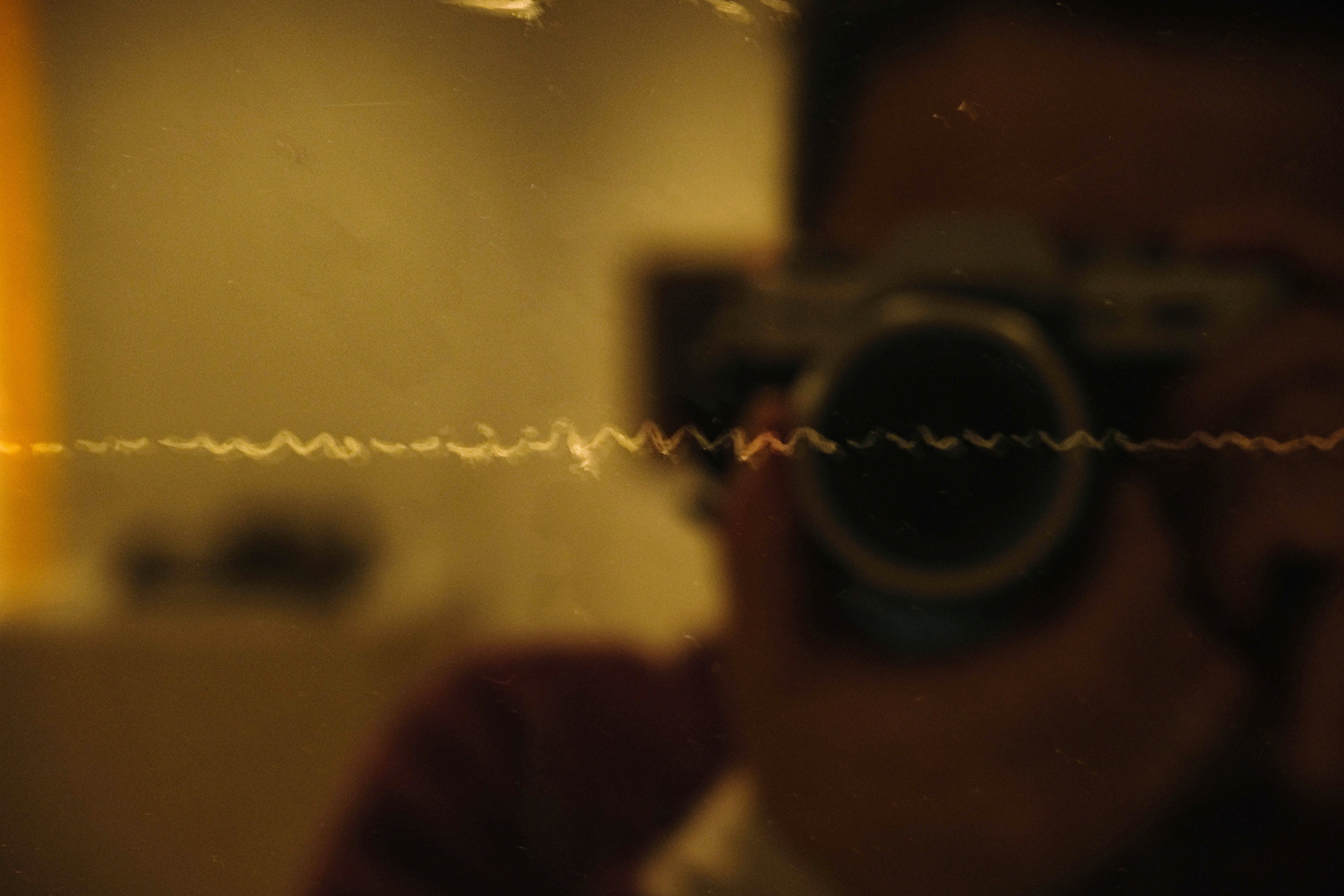Installation view of the exhibition "INVISIBLE POWERS (MOT ANNUAL 2020)"
Sat. 14 Nov, 2020 - Sun. 14 Feb, 2021
Museum of Contemporary Art Tokyo
Sat. 14 Nov, 2020 - Sun. 14 Feb, 2021
Museum of Contemporary Art Tokyo


The distance between telepathy and sympathy
According to a 2001 poll by the US Gallup research agency, when asked “Do you believe in telepathy, or other communication between minds without using the traditional five senses?” 36% of respondents answered “Believe,” 26% answered “Not sure,” and 35% answered “Don’t believe.” Two in three people, this indicates, do not negate that possibility. If so, we must conclude that—regardless of the truth or untruth of its existence—the sixth sense is a deep-seated concept in our lives that we cannot overlook from the perspective of human psychology. We do not know if we have a sixth sense, but our surroundings abound with things (or living organisms) our five senses cannot sense. At times, they surge and threaten the stability of our world. In my pursuit of the invisible, this time I look closely at “representation of invisible sound (vibration).” To capture something invisible and convey it. In this piece, there are some media the majority of which use five senses that cannot be transmitted by Braille, Visible Speech and Low Frequency Waves. Encounter the communication of sensory organs that you do not have. To communicate an intention to a sense organ you do not possess may seem like telepathy to you. Do you really believe only in your five senses? Please touch me. I am not here in this book, but I am here.
⠪⠴⠇⠗⠥⠲⠀⠀⠪⠛⠥⠄⠕⠳⠐⠡⠥⠐⠳⠿⠟⠡⠩⠰⠀⠟⠴⠐⠳⠇⠜⠙⠟⠐⠡⠷⠐⠟⠹⠲⠀⠀ ⠄⠕⠳⠥⠷⠋⠅⠃⠅⠇⠡⠔⠰⠀⠊⠃⠡⠫⠟⠱⠩⠧⠴⠔⠝⠩⠂⠟⠃⠵⠹⠲ ⠪⠴⠡⠃⠥⠰⠄⠷⠙⠪⠞⠎⠐⠟⠣⠅⠡⠂⠕⠊⠞⠰⠀⠳⠴⠐⠞⠉⠎⠈⠮⠉⠈⠺⠉⠠⠆⠇⠈⠕⠩⠾⠩⠳⠟⠃⠵⠹⠲ ⠡⠝⠟⠎⠛⠪⠒⠐⠞⠌⠐⠳⠳⠴⠫⠃⠥⠰⠀⠥⠓⠎⠉⠐⠪⠣⠔⠾⠎⠇⠡⠩⠪⠞⠐⠟⠰⠀⠐⠩⠐⠫⠴⠡⠔⠳⠟⠃⠵⠳⠕⠐⠡⠰⠀ ⠐⠫⠴⠐⠱⠃⠥⠐⠞⠗⠑⠾⠐⠟⠐⠳⠕⠙⠡⠱⠛⠰⠀⠹⠉⠗⠐⠕⠫⠎⠻⠡⠃⠇⠅⠂⠟⠣⠟⠃⠵⠹⠲⠀⠀ ⠵⠕⠰⠀⠐⠣⠘⠹⠝⠎⠳⠴⠠⠮⠌⠰⠀⠡⠴⠻⠴⠈⠺⠉⠕⠃⠱⠩⠇⠜⠂⠟⠰⠀⠻⠡⠃⠾⠰⠀⠋⠣⠈⠺⠉⠡⠳⠟⠣⠟⠃⠵⠹⠲⠀⠀ ⠐⠮⠩⠥⠺⠴⠅⠻⠡⠃⠇⠪⠎⠐⠫⠴⠐⠳⠝⠞⠡⠫⠥⠅⠛⠕⠰⠀⠬⠿⠎⠜⠉⠅⠃⠄⠡⠴⠐⠡⠁⠓⠵⠹⠲ ⠷⠋⠅⠃⠅⠇⠡⠔⠝⠡⠵⠋⠙⠪⠞⠲⠀⠀⠺⠳⠟⠺⠛⠔⠝⠕⠋⠙⠪⠞⠲⠀⠀ ⠁⠅⠕⠥⠃⠵⠰⠀⠪⠎⠟⠣⠹⠞⠔⠰⠀⠈⠺⠂⠡⠩⠐⠫⠴⠐⠪⠐⠟⠁⠙⠰⠀⠟⠴⠐⠳⠞⠳⠟⠜⠴⠐⠟⠃⠵⠹⠐⠡⠰⠀ ⠁⠅⠕⠇⠥⠷⠋⠅⠃⠡⠾⠳⠛⠅⠃⠰⠀⠳⠡⠩⠐⠫⠴⠐⠪⠎⠾⠐⠳⠐⠟⠾⠥⠅⠳⠡⠫⠟⠃⠵⠹⠲⠀⠀ ⠝⠵⠓⠪⠪⠇⠁⠙⠼⠃⠝⠎⠟⠣⠹⠞⠥⠰⠀⠐⠞⠗⠑⠡⠎⠡⠴⠡⠩⠣⠐⠟⠳⠡⠜⠷⠞⠙⠪⠞⠐⠡⠐⠟⠣⠅⠃⠜⠉⠇⠅⠂⠟⠃⠵⠹⠲ ⠵⠕⠰⠀⠱⠩⠧⠴⠐⠟⠾⠰⠀⠳⠄⠮⠉⠞⠃⠉⠰⠀⠪⠋⠔⠐⠕⠱⠐⠹⠇⠩⠗⠎⠉⠐⠪⠣⠐⠟⠥⠅⠳⠡⠫⠙⠋⠃⠐⠺⠉⠾⠁⠙⠕⠿⠰⠀ ⠐⠕⠛⠾⠐⠡⠼⠁⠝⠥⠜⠷⠞⠙⠪⠞⠐⠡⠐⠟⠣⠅⠃⠞⠪⠚⠐⠡⠁⠙⠰⠀⠱⠩⠧⠴⠇⠅⠂⠟⠃⠙⠞⠊⠾⠃⠵⠹⠲⠀⠀ ⠐⠳⠐⠭⠴⠇⠥⠄⠡⠑⠅⠃⠃⠳⠎⠐⠟⠴⠕⠝⠔⠳⠟⠃⠙⠞⠃⠉⠟⠴⠇⠊⠃⠟⠰⠀ ⠾⠳⠡⠳⠕⠑⠺⠛⠥⠟⠛⠠⠥⠳⠒⠎⠜⠉⠅⠡⠴⠡⠩⠅⠎⠡⠾⠳⠛⠵⠻⠴⠲ ⠄⠕⠳⠔⠷⠟⠩⠐⠕⠱⠃⠲⠀⠀⠄⠕⠳⠥⠪⠪⠇⠃⠵⠻⠴⠐⠡⠪⠪⠇⠃⠵⠹⠲


Employing devices and video narratives of his own design, Gaetan Kubo studies invisible relationships underlying paranormal phenomena, phenomena imperceptible to natural science, psychoanalysis and social science. Often, his devices emit the harsh motor energy of rotation, burst, and vibration, suggestive of suppressed desires erupting under the pressures of civilization and rationalization. In his childhood, Kubo experienced the 1990's occult boom and grew interested in the invisible world from exposure to rumors of the supernatural on TV and at school. Thereafter, when the occult boom ended and computerization spread with the explosive growth of the Internet, he felt as if robbed of his imagination. Motivated, thereafter, by a desire to regain his stolen imagination, Kubo in late 2010 embarked on a series of works entitled "Transmission" examining the violence of invisible, anxiety-inducing electromagnetic waves, low-frequency waves, and wireless LAN present around us. Created using home appliances and sound equipment emblematic of civilized society, the works took the form of mysterious devices emitting eerie vibrations and frequencies. For his January 2011 graduation work, he created Poltergeist caused by home electronics, a wall of vibrating built-in appliances and speakers that depicts a world gone mad and approaching its end.
Kubo's first artistic turning point came when the Great Eastern Japan Earthquake struck in March 2011. For Kubo, as one of many artists shifting direction dramatically in response to the earthquake, the turning point meant the shock of seeing the fantasy world of his artworks come true. Thereafter, he took up earthquakes, electricity, radioactivity, low frequency pollution, and invisible forces and energy and inaudible sounds with a new intensity of purpose. Works that reverse the relationship of sanity and insanity became prominent. They include Inverse Panopticon (2012), which takes motifs of rumored low-frequency, artificial seismic weapons and inverse panopticon structures (full-view peripheral supervisory system monitors monitored by the peripheral), and Briareo (2012), a work inspired by conspiracy theories related to the giants and wind turbines in the novel, Don Quixote. Since his 2017 solo exhibition at Kodama Gallery, Kubo has furthermore sought to integrate text with his work in monologues on bizarre observations. This may have been triggered by fieldwork for an artist residency in 2015, when he learned that the first electric generator made in Tokyo employed materials from battleships built in his mother's hometown, Bordeaux, France. By pure coincidence, his subject of research found connection with his own life. Suddenly, he was referencing history related to his own roots as "a non-immigrant immigrant" and giving play to coincidence as a factor in the work. As a result, he obtained a freer, more fanciful associative connection to work with. Monologue, in this context, gave room to the viewer's imagination and became a vehicle for sharing his creativity as an artist.
This exhibition also displays a relatively new form of installation for Kubo connecting an array of devices to the video imagery propelling his monologue. The video begins with a narration about modern inventions devised to capture vibration (sound). These include telephone inventor Alexander Graham Bell's sound recording device, Thomas Edison's gramophone born from the idea of listening to voices of the dead, and the world's first modern seismograph created by Ewing, who invented the first gramophone in Japan. The artist's narration thereafter leaps to folk traditions of associating earthquakes with "catfish" and to the notion of "earthquake weather" and jinari —the capability of animals to detect mysterious sounds that precede earthquakes. The use of modern devices to understand and predict sound / vibration as an invisible energy, on one hand; and the use of animal powers to detect astonishing natural phenomena, on the other. As if to symbolize this parallel world, a seismograph, gramophone, catfish drawing and other historical materials are arrayed together in the gallery. Also displayed is a catfish-style seismograph / power generator Kubo has created himself. The devices serve in the role of reconciling and melding these two incompatible worlds. In the video, Kubo states as follows:
Many sounds exist and make our earth move even though humans can't hear them. We cannot escape from sounds... The World is full of sounds.
Many sounds exist and make our earth move even though humans can't hear them. We cannot escape from sounds... The World is full of sounds.
The monologue ends with the artist talking to the audience in an imperceptible voice, but gradually—as if prompted by a powerful kotodama (word spirit) —a rumbling of the ground and vibrations assault the viewer from behind. The world, it is implied, is filled with vibration (energy). The attempt to measure that world through science and the attempt to reproduce it in a tangible form are two sides of the same coin. Both are indispensable human activities. Here, Kubo has not only reproduced the vibration by amplifying the sound of G (as his initial Gaetan), but also hand-traced historical images of the discoveries and inventions concerning sound / vibration in "Contact of Dream: Experimental image" series. By doing so, he is exploring the question of whether human actions do produce "something" to counter the invisible menace that repeatedly comes around in cycles. This work examining invisible sound (vibration) is a work that returns to Kubo's starting point, his "Transmission" series. Today, when the word "transmission" carries new and different nuances (message transmission, contagion), Kubo's works recreate and display the ways in which the world's invisible powers burst out as the result of friction or contact.
ODAKA Hikari
From the exhibition catalogue of "Invisible Powers"
Curator, Museum of Contemporary Art Tokyo
Curator, Museum of Contemporary Art Tokyo
世界は音で満たされている | The world is full of sounds
2020
2020
ビデオ、電話、振動壁
Video,telephone, vibrating wall
Video,telephone, vibrating wall
Braille text is printed under the Japanese and English statement at the entrance. Some information in the text is not contained in the Japanese and English statements. Likewise, the lip speaking that appears in a video in this work is also a media form that can’t be read or understood by the majority of people who use their five senses. Perhaps, no one can comprehend all the symbols used in this work and I believe this is what artwork generally is. Despite that, I’m offering you this handout to give you a deeper insight into the works. If you are willing to view them once again, in other words, “replay” the journey, please start by touching the Braille.
Hegel said, “History repeats itself,” to which Marx added, “first as tragedy, second as farce”. But before you start to “play” this, I’d like to impress this upon you: a farce doesn’t guarantee a happy ending. Its depend with your distance to see it. And farce is subjective. You have to prepare for what could happen some day. Because the third time could be a tragedy.
Hegel said, “History repeats itself,” to which Marx added, “first as tragedy, second as farce”. But before you start to “play” this, I’d like to impress this upon you: a farce doesn’t guarantee a happy ending. Its depend with your distance to see it. And farce is subjective. You have to prepare for what could happen some day. Because the third time could be a tragedy.
The number I dial in the video is 400. Used for dial and busy tones, 400Hz is also close to chord G4. A speaker is embedded in the wall behind and at the end of the video, the room is shaken by a sonic wave tuned to G.
Feel free to answer the phone when it rings.
Feel free to answer the phone when it rings.
聞こえないけど聴こえてる | I cannot hear you but I can listen to you
2020
ナマズ式音力発電装置
Sound electric generator using catfish
Sound electric generator using catfish
A stethoscope, set at almost the same height as my heart, was converted into a microphone. It picks up the sound of my monologue coming from the wall. The sound is then passed on by short-circuiting through a catfish skin, where it’s rectified and amplified by an effector, and finally outputted to a speaker under the tank. It ripples the surface of the water and the vibrations power the electricity generator under the tank. I placed an object in the shape of my ears on the right and left sides of the tank, the head of a catfish at the back, its tail at the front, and tuning-forks that produce a sine wave at every corner. This is a “catfish sound vibration electricity generator” that combines magic and science —a folk belief that the skull of a catfish looks like a cross combined with cymatics studies that observe the wave patterns of wheat grains on a glass plate formed by vibrating the plate with a violin bow.
夢との交信:サミュエル・モーランド 「拡声する人間チューバ」の再生実験
Contact of Dream: Experimental image reproducing of [Tuba stentoro-phonica] by Samuel Morland
2020
Contact of Dream: Experimental image reproducing of [Tuba stentoro-phonica] by Samuel Morland
2020
1671 年の図版をアメリカ議会図書館Music Division デジタルデータ( パブリックドメイン) よりトレースし銅版を復元
Chalcography made from an image of 1671 by tracing a digital data of Library of Congress, Music Division (Public Domain)
Chalcography made from an image of 1671 by tracing a digital data of Library of Congress, Music Division (Public Domain)
I wonder when human beings first recognized sounds? Pythagoras found a tone scale from the differences in sounds made by the hammer of a blacksmith, and Aristotle noted the existence of soundwaves. There are some interesting points in this iconography that was published by Samuel Morland in 1671. In the iconography, which was announced as the invention of the megaphone, he focused not only on the expansion of sound but also its multiplication, and the sounds of voices resonating with each other. From this, we realize the world is full of sounds.
This work and another copperplate work are the inverse of the original digital data that was transcribed in the original block print. Each copperplate was etched and filled with ink, making it the reverse of the original block print. In other words, it is stored as it is and the lines are not inked.
This work and another copperplate work are the inverse of the original digital data that was transcribed in the original block print. Each copperplate was etched and filled with ink, making it the reverse of the original block print. In other words, it is stored as it is and the lines are not inked.
夢との交信:アタナシウス・キルヒャー 「言葉を話す像のしかけ」の再生実験
Contact of Dream: Experimental image reproducing of
[Speaking statues connected to the wall] by Athanasius Kircher
2020
Contact of Dream: Experimental image reproducing of
[Speaking statues connected to the wall] by Athanasius Kircher
2020
1650 年の図版をポーランド国立図書館デジタルデータ( パブリックドメイン) よりトレースし銅版を復元
Chalcography made from an image of 1650 by tracing a digital data of National Library of Poland (Public Domain)
Chalcography made from an image of 1650 by tracing a digital data of National Library of Poland (Public Domain)
This iconography of Athanasius Kircher’s invention shows the mechanism of a megaphone in the wall catching outside sounds and consolidating them before outputting from its narrow end, next to a mouth of a statue, to make it sound as if the statue is talking. The work of the voice coming out from the wall in this exhibition is the embodiment of this fantasy.
大石真虎[ 画]《俗説地底鯰之図 *永暦大雑書天文大成より》
Matora Oishi (Drawing) "Map of Catfish in the bowels of the Japan.
From Eiryaku-era astronomical fortune telling encyclopedia"
c1834
Matora Oishi (Drawing) "Map of Catfish in the bowels of the Japan.
From Eiryaku-era astronomical fortune telling encyclopedia"
c1834
本
Book
Book
This is a fortune-telling book based on Chinese astrology, called zassho. These books were widely spread throughout the Edo era. At the beginning of most zassho, there was a map of a Japanese island covered by a drawing of a huge “earthquake bug” like a dragon. Before catfish drawings became popular, this was a creation from the imagination of people who wondered where the huge shaking came from.
張衡の地動儀を模した茶壷
A canister for tea leaves resembling Zhang Heng's seismoscope
Unknown (The original seismoscope: c132)
A canister for tea leaves resembling Zhang Heng's seismoscope
Unknown (The original seismoscope: c132)
茶壷
Canister for tea leaves
Canister for tea leaves
Zhang Heng’s seismoscope is supposedly the world’s first seismograph. Invented by a Chinese scholar, Zhang Heng, in 132 CE, it was able to detect distant earthquakes and roughly determine the direction from where each earthquake occurred. To indicate this, the device dropped a ball from a metal dragon head into the mouth of a corresponding metal toad. When we consider Japan’s first seismograph, which was invented in the Meiji era (1868-1912) by o-yatoi gaikokujin (hired foreigner), Zhang Heng invented his seismoscope surprisingly early. None of the original devices survive, nor do the blueprints, so the inner structure of the device is still shrouded in mystery. Thus, there are various theories regarding the seismoscope.